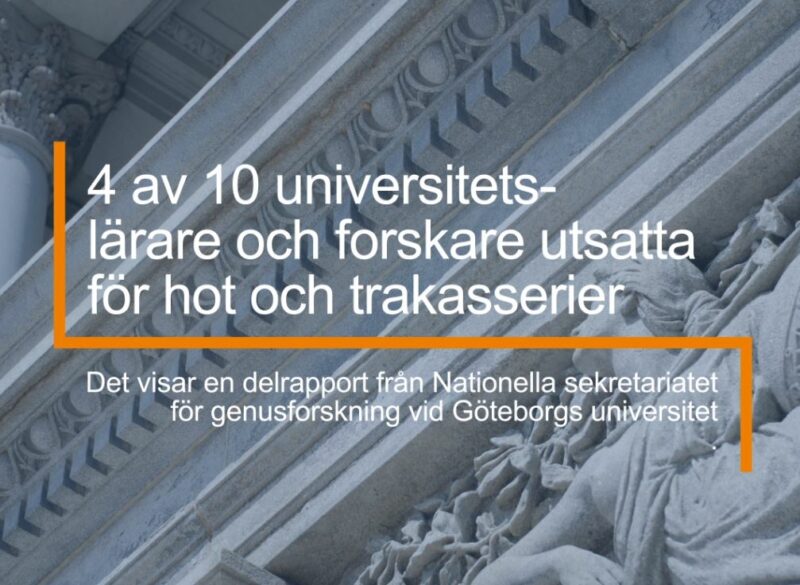New report: Threats and harassment are common in Swedish academia

For the first time a study has been conducted on the prevalence and consequences of threats and harassment against researchers and university teachers in Sweden. The most common forms of harassment are threats in emails, in statements face to face, and threats online and on social media. Consequences of harassment, and even of the risk of being harassed, are that researchers avoid certain research areas or to comment on certain issues. Some even consider leaving the academia.
“Experiences of threats and harassment seem to be common in the academia, and this means a great challenge for higher education institutions”, says David Brax, researcher and Senior Advisor at the Swedish Secretariat for Gender Research, who has written the report.
The study is based on a questionnaire answered by members of Sweden's university teachers and researchers, SULF. The results indicate that the most common kinds of threats and harassments in academia are threatening e-mails (18%, of the 2847 people who responded to the survey), threatening statements face to face (11%) and attacks on social media (9%). Violence, theft and vandalism is occurent, but to a lesser extent (6%).
Harassment most commonly from students or colleagues
One of the most pronounced results of the study is that threats and harassment in academia usually come from a student (says 48% of those who had been exposed), then colleagues (19%). The perpetrator is usually known to the person who is exposed and women are more often exposed than men.
Many of those who in the survey answered that they have been subjected to threats and harassment state that they were exposed by a student, or by someone else at their own institution or unit, and that this often has happened in teaching situations.
“The results indicate that the threat comes primarily from within the academic environment, which requires a different type of handling than threats coming from outside, from people who do not belong to the workplace at all”, says David Brax.
Consequences of exposure to threats and hatred are severe
The research areas humanities and social sciences seem to be more exposed than other research areas according to this study. The results also indicate that exposure in social media and in science communication increases the risk of being exposed. An important societal aspect of threats and harassment is the risk of freedom of speech being constrained and that important conversations are silenced. Other important aspects are the impact on individuals' ability and opportunities to continue conducting research on all kinds of topics, or on advancing in their academic career.
The consequences of being exposed to threats and harassment, as well as fear of being exposed, are that many people avoid certain research areas or issues. For example, the study shows that 17 percent of those who have been subjected to threats and harassment have considered leaving the academia. Many (26%) have avoided getting involved in a particular issue, 23 percent have hesitated before a decision and 20 percent have refrained from speaking out as a researcher.
“Consequences of threats and harassment are very serious, no matter how common it is. We can conclude from the survey that many are limited by the risks, which in effect mean that there are research that society could benefit from, that simply does not disseminate”, says David Brax.
Link to the interim report (in Swedish only): ”Delrapport: Hot och hat mot forskare och lärare vid svenska universitet och lärosäten” (pdf)
Facts about the study
- The study is a collaboration between SULF, The Association of Swedish Higher Education Institutions, SUHF, and the Swedish Secretariat for Gender Research at the University of Gothenburg.
- In Sweden, exposure to hatred and threats has been studied in other occupational groups with exposure to the public light (eg politicians, journalists and cultural workers), but this survey is the first of its kind on the exposure of researchers and university teachers.
- About 3,000 university teachers and researchers have responded to the survey
- The study aims to explore how many people have experienced threats and hate and why, and the consequences this has had for victims
- The aim is to improve preventive efforts and provide greater support for those exposed to hate and threats
- An interim report of the study is to be presented 4:th of July, at a seminar during Almedalen Week.
- The final report will be presented in autumn 2022.